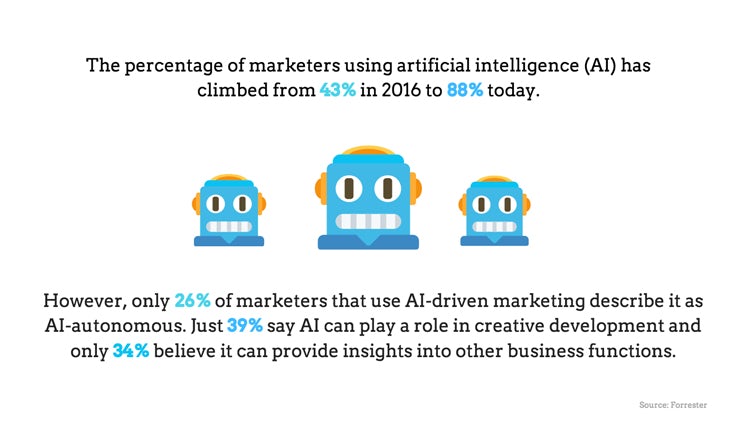Online shopping, customer experience, AI: 5 killer stats to start your week
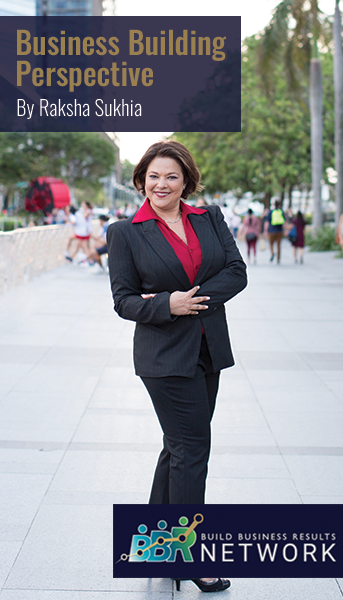
The marketing world is dynamic and ever-changing — trends, technology, and tactics are never stagnant. That's why it's critical that your business stay up with new developments in the industry. The last thing you want is for your business to fall behind while your competitors stay ahead of the curve. But how can you be sure you're keeping up with the times? A great way to remain relevant and stay up to date on all marketing trends is to keep an eye on marketing statistics.
And If you want to get your business or sales funnel launched fast to attract clients consistently, do check out our IGNITE Business Accelerator Program that runs weekly though September and October and Is available Live Online or In Person for DC Area Residents held at the Reston Chamber of Commerce.
See you on the action-field,
Raksha Sukhia, SMB Growth Expert,
Founder BBR Network. #bbrnetwork
Online shopping, customer experience, AI: 5 killer stats to start your week
1. Most Online marketers are using AI but are disappointed in the results
The percentage of marketers using artificial intelligence (AI) has climbed from 43% in 2016 to 88% today, indicating AI’s increasing advances in marketing technology, as well as marketers’ desire for better decisions, greater productivity, and faster execution.
However, only 26% of marketers that use AI-driven marketing describe it as AI-autonomous, which means it can act on its own insights and work collaboratively with marketers without adding manual work. Just 39% say AI can play a role in creative development and only 34% believe it can provide insights into other business functions.
In addition, the report indicates AI is not addressing the fundamental operational and technical complexity that controls marketing performance. Some 47% of marketers say it’s to blame for their customer engagement tactics not being as relevant as they should be, and another 37% say it’s the reason customer engagement is not delivered in the optimal channel.
Source: Forrester
2. Almost a quarter of online shoppers have made a direct purchase from a social media ad
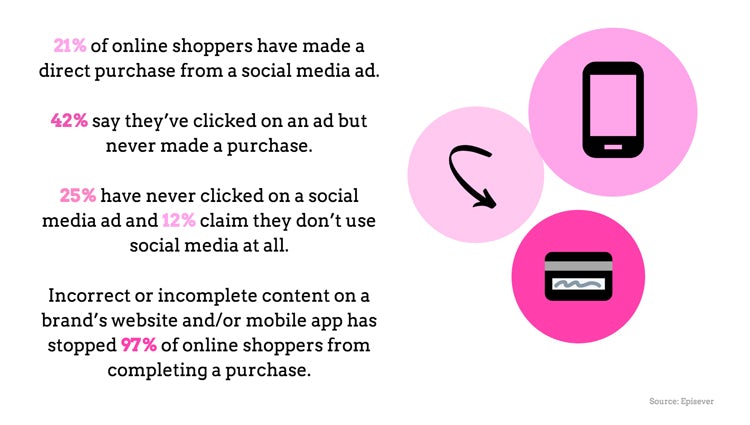
A fifth (21%) of online shoppers have made a direct purchase from a social media ad, while 42% say they’ve clicked on an ad but never made a purchase. Another 25% have never clicked on a social media ad, while 12% claim they don’t use social media at all.
More than half (52%) of online shoppers who use social media have clicked on an influencer’s post, with 31% of those making a direct purchase from the post.
Almost a quarter (21%) of online shoppers aged 37 and under turn to social media for inspiration online when they do not have a product in mind for purchase, compared to just 5% of online shoppers over the age of 38.
Incorrect or incomplete content on a brand’s website and/or mobile app has stopped 97% of online shoppers from completing a purchase.
Source: Episever
3. Government more trustworthy than influencers
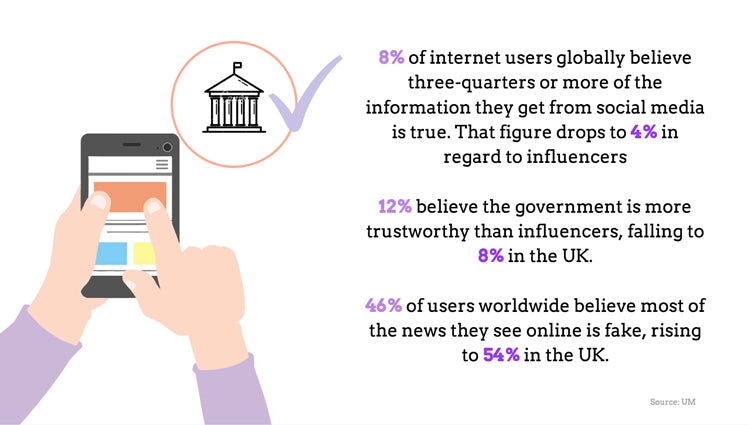
Just 8% of internet users globally believe that three-quarters or more of the information they get from social media is true. That figure drops to 4% in regard to influencers, bloggers and vloggers.
Even the government is considered to be more trustworthy than majority of influencers, with 12% believing governments are mostly truthful. However, this figure falls to 8% in the UK.
Almost half of internet users worldwide (46%) believe most of the news they see online is fake, rising to 54% in the UK.
Meanwhile, 47% globally and 44% in the UK say they are influenced by opinions shared online.
Source: UM
4. Ads targeted at relevant activities boost impact
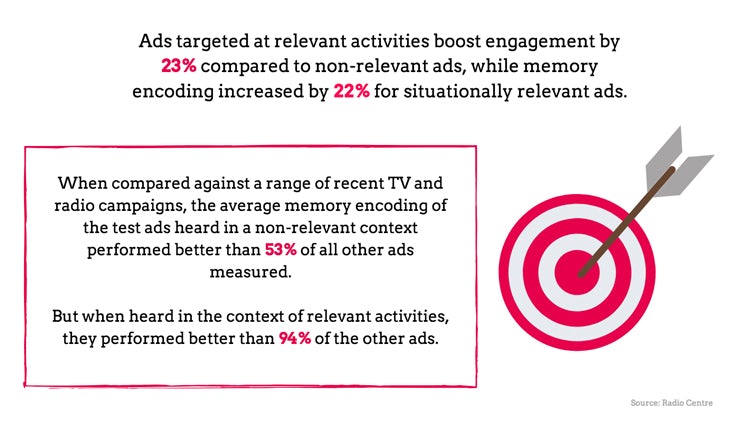
Adverts targeted at audiences as they carry out relevant activities can significantly boost the impact of advertising effectiveness in engagement.
Engagement climbs by 23% compared to non-relevant ads, while memory encoding – the mental process of turning an experience into a memory – increases by 22% for situationally relevant ads.
For instance, when compared against a range of recent TV and radio campaigns measured by Neuro-Insight, the average memory encoding of the test ads heard in a non-relevant context performed better than 53% of all other ads measured.
But when they were heard in the context of relevant activities, they performed better than 94% of the other ads.
Source: Radiocentre
5. One in three CMOs haven’t invested in customer experience
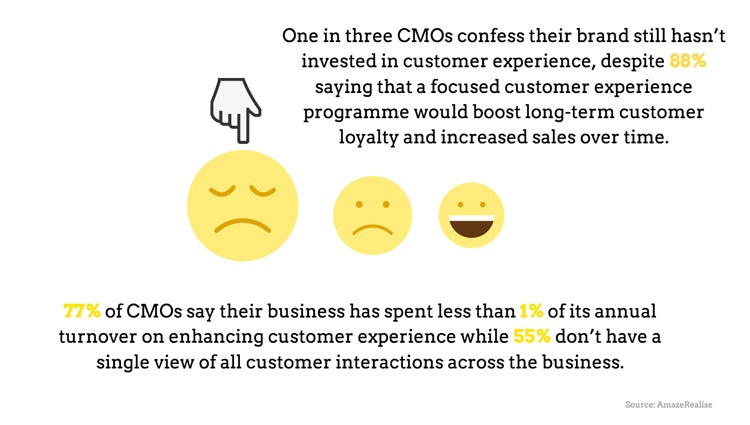
One in three CMOs confess their brand still hasn’t invested in customer experience, despite 88% saying that a focused customer experience programme would boost long-term customer loyalty and increased sales over time.
Another 77% of CMOs say their business has spent less than 1% of its annual turnover on enhancing customer experience. 22% say the lack of investment comes from organisational blockers and team structure, while 11% blame a lack of C-suite support and senior buy-in.
44% predict customer experience initiatives to lead to a decrease in costs and 25% believe they will attract new customers through word-of-mouth recommendation.
55% don’t have a single view of all customer interactions across the business.
Source: Erin Lyons., MarketingWeek/AmazeRealise
Related Article
What’s a Good Landing Page Conversion Rate?
Business Agility Is the New Norm. Do You Have What It Takes?
Tags
AmazeRealise, #BBR Network, #Profitability, #Small Business Administration, #Small Business Growth, #Small Business Marketing and Sales, #SMB, #SME, Advertisements, AI, Artifiical Intelligence, Build Business Results, Build Business Results (BBR), Build Business Results (BBR) Business Advisory, Build Business Results (BBR) Mastermind., Build Business Results (BBR) Network, Build Business Results (BBR) Network Business Advisory, Build Business Results (BBR) Network Members, business inspiration, chief marketing officer, CMO, Episever, Forrester, influencers, Marketing, Marketingweek, Online, Online Shopping, Radiocentre, Raksha Sukhia, Social Media, Social Media Marketing

